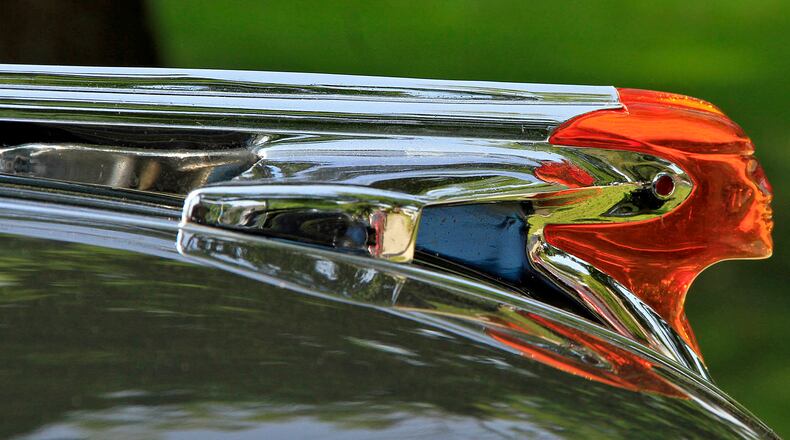To understand the hood ornament, we must travel back over a century when automakers like Ford moved their engines from beneath the body to in front of it, exposing the radiator.
“On the old Model Ts and Model As, the “ornament” was actually a radiator thermometer, so the driver could tell at a glance if the engine was about to overheat,” said Carol Leigh, photographer of classic hood ornaments. “As cars became sleeker, more elegant, the radiator thermometer morphed into a sign of luxury, a prominent advertisement of sorts for the car, and a symbol of more modern times.”
Automakers seemingly entered a radiator-topped arms race that strengthened their brands. The Jaguar leaper, Pierce Arrow archer and Plymouth Mayflower bridged the Jazz Age into Art Deco bliss. Chrysler’s winged logo first flew from a radiator. Bentleys wore Bs on their bonnets. By the 1950s, cars embraced the jet age with bombsites and jet planes on hoods and fenders.
No ornament is more famous than the “Spirit of Ecstasy” that has topped Rolls-Royce grilles since 1922. Created by sculptor Charles Sykes and based on real-life Eleanor Thornton, she was originally 7 inches tall, but is now 3 inches and can retract into the radiator shell for protection. The sculptures are created in 24-carat gold, sterling silver, glass, stainless steel and illuminated versions. In 2011, Mouawad Jewelers created a diamond-enrobed version valued at $250,000.
The Flying Lady’s reign atop Rolls-Royce bonnets outlasted Cadillac’s crest, which has fallen to grilles across the lineup. The famous logo, based on Detroit founder Antoine de la Mothe Cadillac’s coat of arms, even lost its famous wreath recently in a nod to modernity.
This downward regression from hood to grille has increasingly affected Mercedes-Benz, too. Prior to the 1955 300SL “Gullwing,” stars sat atop radiators, but the supercar introduced a sportier star hung on a single lamella in the grille. That became the standard for Mercedes’ sports cars, but today’s A-, C- and E-Class sedans are predominantly grille swaggers, too.
“When Gottlieb Daimler build the first Mercedes cars around the turn of the last century, the cap of the coolers where customers filled in the water was the ideal platform for his brand logo,” said Gorden Wagener, chief design officer, Mercedes-Benz. “The three-pointed star on the hood, especially on the S-Class, is the symbol of a traditional Mercedes three-box luxury limousine. Our specific grille design with the star on the hood represents sovereignty, desirable luxury and is famous around the world.”
And it is the changing face of luxury, evolving toward casual over formality, that may most affect where ornaments are located, forcing them from hood to grille on the cars Wagener designs.
“Many customers desired our sports grille in more models like our (sedans) because racing is in our genes and that grille represents this dynamic attitude,” Wagener continued. “Our cars deliver what their sporty look promises.”
Which grille you prefer may depend on your sense of history – and where you live.
“This changes from market to market and within customer groups around the world,” Wagener said. “In the U.S. you’ll find more sporty people because sports or competition is a natural part of the American life. So, the grille-mounted star is the perfect brand fit for your mindset. Mercedes is racing, competition with fair rules and values, and we stand for this attitude.”
Photographer Carol Leigh may know hood ornaments better than anybody as she’s captured countless versions.
“I’ve been photographing hood ornaments since the mid-1980s and never tire of the quest to find different backgrounds and shadows for my photo files,” Leigh said. “All the ones I’ve photographed over the years I’ve found at outdoor car shows. Yes, there are more pristine and more unique hood ornaments on the cars inside museums, but it’s the thrill of the hunt I enjoy.”
There’s the ethereal “Silver Streak” ornament from a 1939 Pontiac that, as Carol says, looks “Batman-esque and implies a sense of power” and the Griffin from a 1933 Essex Terraplane that’s “fierce and substantial”, though pitted with time. Other gems include the “space-age Airplane Jet Eagle” from the 1955 Chevrolet Bel Air and arching chrome quail from a 1931 Ford.
Look through her entire collection to see the sleek greyhound from a 1936 Ford, graceful stretching lady from a 1933 Oldsmobile, and Continental star shadowing an orange hood.
“They may seem passé today, but hood ornaments always catch my eye,” Leigh said. “They fascinate me because they are different from one another, look cool and often symbolize the history of America. I find them all beautiful, from the pitted metal Griffin to the sleek female figure sweeping backward, they all look great to me. There is a glass rooster head I photographed at a Concours d’Elegance in southern California that I remember fondly.”
There’s a beauty in their glimmering chrome, ethereal origins and symbols hood ornaments became. Art deco birds and chrome jets are no more, but others will stand proud for decades to come.
“As long as I’m the responsible chief design officer there always will be cars with an upright star on the hood,” Wagener said. “At least at the Mercedes S-Class and Maybach. We came a long way and we worked hard for this, and customers love it for exactly this symbolic power.”
There is nothing like gazing down a long hood to see a three-pointed star, flying B, or winged goddess edging their steed down a long highway. After watching their sculpted backsides for thousands of miles, placing them anywhere else seems silly. And, if Wagener’s comments and Rolls-Royce’s recent 103EX autonomous EV concept are indications, drivers and passengers will enjoy that experience ad infinitum.
Check out Carol Leigh’s automotive photography at carol-leigh.pixels.com/collections/old+cars+parts
About the Author

